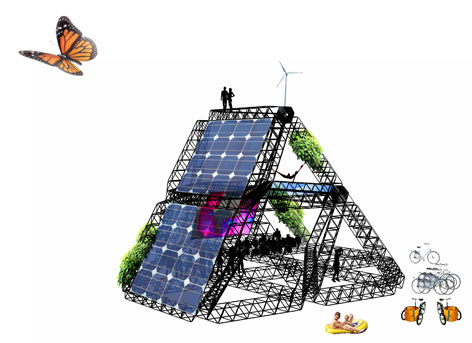 |
|
|
Introduction:
The POWERSTATION aims to empower persons in a local area to change their situation. It is a low cost,
lightweight autonomous structure that is able to harvest the necessary energy from the local environment. It
offers a wide range of facilities. It distributes energy, food, water, and access to the internet for free. It
also provides equipment for activities like concerts, theater, meetings and various games. And it functions as
a caravanserai, meaning that users can take a bath, cook their food or find a place to sleep. Traditionally in
the old Arabic countries a caravanserai was a place for travelers to water their camels and rest before the
continuation of their journey. The POWERSTATION provides a similar updated version of this for free. Persons
passing by can enjoy a performance, enjoy the view from the platform on the top, play a concert, share the
contents of their ipod or computer on a big screen or have a cup of tea. Recharge their mobile phone, or their
electrical bike. Furthermore it encourages local persons to set up small businesses in relation to events
taking place. When the POWERSTATION has been implemented in a specific area, all decisions, maintenance etc
will be taken care of by groups of local persons. This could be already existing groups like sports clubs,
theater groups, or similar existing local groups. Alternatively a new group could be set up to operate the
POWERSTATION on a daily basis
The POWERSTATION can easily be moved if necessary. It offers both enclosed spaces and open areas like a scene
for concerts or theater activities.
The POWERSTATION can be scaled up and down according to local needs
Construction:
The main construction is made from 57 aluminum beams. Each beam is constructed from a number of square tubes.
The overall dimensions are based on a binary system of numbers.The pattern in which the struts are placed to
form the beams are repeated in the macro structure Each beam weighs only approximately 27 kg if they are 5
meters long. The prototype version of the POWERSTATION will be about 9 meters high and cover an area of
150 square meters at the base. The net area of the two levels together are 190 square meters.The building
system is a new version of the octet truss, created from very few parts: Square tubes and rivets. ( Please see
structural model below)
Parts of the construction will offer shelter from the rain provided by suspended textiles, transparent tarps, or inflated plastic foils. Other parts will be completely open. Public address systems and lights are integrated into the main construction. The same goes for various form of equipment like computers allowing persons to access the internet
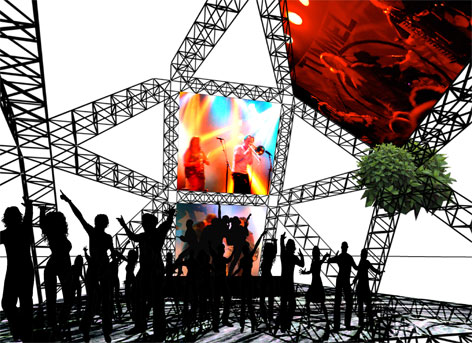
and an energy bank that stores energy harvested locally by small windmills and solar panels mounted on one
side of the building. Rainwater is collected from the surface of the building and cleaned to drinking water
standards.
Hammocks are integrated in the structure to provide places to rest and sleep as well as showers, compost
toilets and cooking facilities Bicycles will be available for free, for persons to explore the local
area. A hydroponics plant growing system is integrated in the building, that would allow local persons to grow
anything from vegetables to herbs. In the nighttime the POWERSTATION will be illuminated by lights integrated
in the beams
The base of the building is provided by a number of spiral- drills, normally used for drilling holes in soil,
but in this case left in the ground to provide the mooring and stability of the building. This makes it an
easy process to dismantle the building in order to move it when needed. The POWERSTATION is constructed using
highly durable materials that require little maintenance. No surface protection like paint is required.
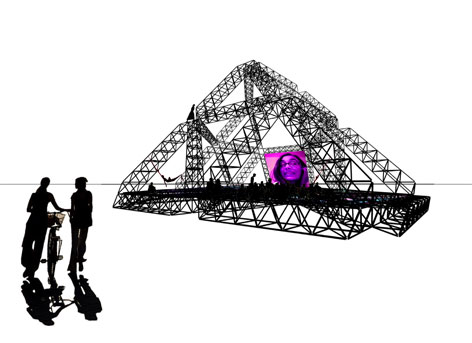
Background:
The POWERSTATION should have been realized in collaboration with the 2010 European Capital of Culture. It
should have been situated in an appropriate place along the River of Emscher in the Ruhr district of
Germany. The history of the area played an important role for this proposal: The former industrial
center of the western world, now surviving in a situation burdened by low employment rates etc. Therefore
anchoring the POWERSTATION in the local social, political and economical situation in a harmonious and apt way
was of the outmost importance. But the budget was limited and it was decided to use the WALKING HOUSE for this
occasion instead. Nevertheless N55 are looking forward to get at chance to realize POWERSTATION in another
situation
Extensions:
The POWERSTATION can easily be extended and new functions added according to the wishes and decisions of the
users.
Health and safety issues:
Fire hazards:
The amount of flammable material inside the prototype will not lead to a structural breakdown of the structure
in case of fire. However, persons inside the room would have to be evacuated in case of fire
Fire extinguishers will be available inside the structure.
Maintenance:
The maintenance will be the responsibility of local collaborators as mentioned earlier. A part of the
construction budget could be allocated for this purpose to take care of the basics. Later money could be
raised for maintenance by making special events at the POWERSTATION. The main structure requires very little
maintenance, but technical equipment will need to be maintained on a regular basis.
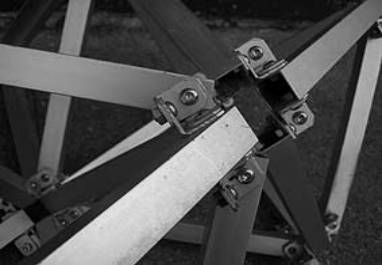
Aluminum model of connection points
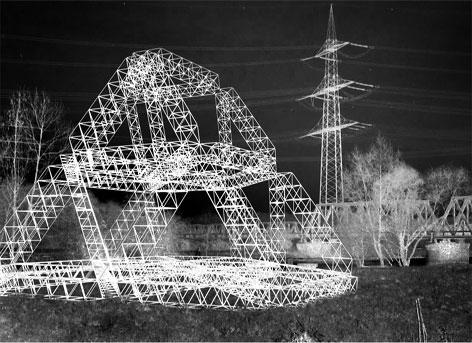
By N55/ Ion Sørvin and Øivind Alexander Slaatto In Collaboration with Erling Sørvin
Technical assistance: Peter Balch Berthelsen